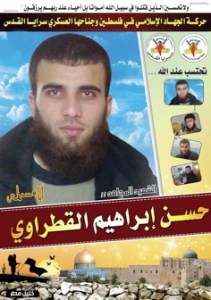
While participating in jihad gives a jihadist important religious credibility, death in battle provides immortality, as the deceased is ranked a martyr. It is believed that Muslim martyrs will be highly rewarded in the afterlife for their sacrifice and hold a special position in heavenly paradise. It is therefore not surprising that martyrdom is a central theme in jihadi visual propaganda.
The caption at the top of the image follows the typical formula for honoring the dead. First, following common Muslim funerary epigraphy, the inscription contains a Qur’anic verse. Specifically, the text partially quotes Qur’anic verse 3:169, which reads: “wa-la tahsabanna lladhina qutilu fi sabil Allah amwatan bal ahya’un ‘inda rabbihim yurzaqun” (“Do not consider those killed in the path of God dead, on the contrary, they are alive, being sustained by God”). Most often the inscription will also include the name of the deceased and the date of death. Here, the text reads: “harakat al-jihad al-islami fi filastin wa-janahiha al-‘askari saraya al-quds tahtasibu ‘inda Allah al-shahid al-mujahid aba maslama hasan ibrahim al-qatrawi” (“PIJ [Palestinian Islamic Jihad] and its military wing Saraya al-Quds considers the martyred fighter Abu Maslama Hasan Ibrahim al-Qatrawi to be with God”). Abu Maslama was reportedly a student of the shaykh Abu al-Nur al-Maqdisi, deceased leader of Jund Ansar Allah (JAA) and a member of JAA, who was killed January 10, 2010. The fact that the image was produced by PIJ indicates membership crossover between PIJ and JAA.
In addition to the picture of the deceased and the caption, the image contains a number of elements that are part of the jihadi visual propaganda repertoire, including the Dome of the Rock. While Muslims across sectarian lines share a reverence for many holy sites, some sites hold special significance for certain groups. For instance, the Dome of the Rock is recognized and revered by all Muslims, as it was built in 692 A.D. by the Umayyid caliph ‘Abd al-Malik on the site where Muslims believe the Prophet Muhammad ascended to heaven in his mi‘raj (night journey). Indeed, it is considered the third holiest site in Islam after Mecca and al-Madina. At the same time, the Dome of the Rock is a powerful symbol of Palestinian nationhood.
More Information
According to prophetic tradition (hadith), the black flag was the battle flag of the Prophet Muhammad and it was carried into battle by many of his companions. Furthermore, in the 8th century, the flag was used by the ‘Abbasids during their revolution against the ruling Umayyad clan and its Caliphate. The image of the black flag has been used as a symbol of religious revolt and engagement in battle (i.e., jihad). In the contemporary Islamist movement, the black flag is used to evoke notions of jihad and of reestablishing the Islamic Caliphate.
 Skip to content
Skip to content
